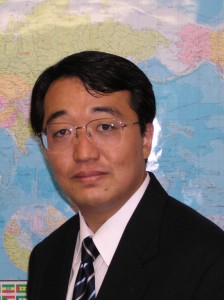緊張と統合:内村鑑三におけるキリスト教と日本の精神
このシリーズでは、私が1994年に執筆した統一神学大学院(Unification Theological Seminary)の神学課程修士論文(Divinity Thesis)を日英二か国語で掲載している。
7.無教会運動の評価の続き
西欧では、普遍主義が多くの脈絡において戦士の忠誠倫理を変化させ、あるいはこれに取って変わった。古い個別主義的忠誠は、より普遍主義的な忠誠によって置き換えられたのである。しかし日本ではこれに反して、個別主義がさしたる挑戦も受けることなく保持されて来たのである。したがって、ヤハウェ以外には如何なる神も認めないキリスト教に改宗し、その結果として教会の会員たる資格を取得することは、不可避的にそれに対する社会的圧力を生じさせる様な、「逸脱した行為」なのである。
政治的権威に対する強烈かつ圧倒的な忠誠は、「恩」という観念の中に存在している。政治的権威は、それに服従する民衆に恩をほどこす義務がある。恩の概念とならぶものは、「報恩」あるいは「恩がえし」の概念である。これは政治的権威の命令を尊重し、それに従って行動する一般的義務を含んでいる。
徳川時代の社会では、家庭は多くの面で社会全体の小宇宙であったことを想起することは重要である。広義では家庭と国家は同一であり、家庭は政体に対立せず、その中に統合され、政体がある程度まで家庭に浸透しているのである。それは異なる価値体系の存在する場ではなく、むしろ本質的には同一の価値体系の働く場なのである。
日本では、社会における基礎的集団、すなわち国家と家庭が、世俗的組織としてばかりでなく、宗教的組織として考えられているという事実からして、宗教は、中心的価値体系に究極的意味の背景を提示していると言える。これらの集団とその首長に対する忠誠心は、たんに世俗的な意味ばかりでなく、究極的な意味をもっていたのである。すわなち集団とその首長に対する義務を果たす事は、ある意味で宗教的な義務であった。その結果、日本人は教派や神社・仏閣となんら必然的なつながりを持たない、「孝の宗教」と「忠の宗教」を発達させたのである。
日本の宗教には、神についての二つの基礎的概念がある様に思われる。第一は、食物、戒め、愛などを与えてくれる超従属的存在の概念である。これには、たとえば儒教の天と地、阿弥陀や他の仏陀、神道の神々がその例であり、地域的守護神や祖先などもこれに入る。この種のものは、次第に政治的上位者や両親に形を変え、彼等は、少なくとも部分的には神聖なものとして取り扱われるようになる。慈悲深い超従属的存在としての神に関する行為は、ただちに「恩」の理論を生み出す。神はなんらかの形で恩を与え、このような恩に対して返礼する事(報恩)が、恩を受けた者の義務である。したがって、宗教行為とは、この報恩がとるさまざまな形式なのである。事実、恩と報恩の理論は、日本の仏教において顕著に認められる。
VII. Evaluation of the Mukyokai Movement.(Cont.)
In the West universalism in many contexts transformed or replaced the ethic of warrior loyalty. For example, the old particularistic loyalty was replaced by a more universalistic loyalty. In Japan, on the contrary, particularism remained unchallenged.(5) Therefore, conversion to Christianity, which acknowledges no gods but Yahweh, and subsequent acquisition of church membership is “deviant behavior,” which inevitably causes a social pressure against it.(6)
The compelling and overriding loyalty toward the political authority must be seen in the context of the idea of on (blessing). The political authority has the obligation of bestowing blessings (on) on the people subject to it. Coordinate with the concept of on is the concept of ho-on or the return of on. This involves the general obligation to respect and comply with the orders of the political authority.(7)
It is important to remember that the family in Tokugawa society was in many ways a microcosms of the total society, it had largely the same value system and was penetrated with the same tensions as the total society. On the broadest level family and nation are one, therefore, the families do not stand over against the polity but is integrated into it and to an extent penetrated by it. It does not serve as a locus for a different value system, but a virtually identical one.(8)
Religion supplied a context of ultimate meaning to the central value system through the fact that the primary collectivities in the society – the nation and family – were conceived of as religious as well as secular bodies. Loyalty to these collectivities and their heads had not only a mundane significance, but also an ultimate meaning; fulfillment of obligations to them was in one sense a religious duty.(9) As a result, Japanese people developed the “religion of filial piety” and “religion of loyalty” which have no necessary connection with sect, shrine, or temple.(10)
There seem to be two basic conceptions of the divinity in Japanese religion. The first of these is that of a superordinate entity who dispenses nurturance, care and love. Examples include the Confucian Heaven and Earth, Amida and other Buddhas, the Shinto deities, as well as local tutelary deities and ancestors. This category shades off imperceptibly into political superiors and parents, both of whom are treated as in part, at least, sacred. Religious action toward these entities is characterized by respect, gratitude for blessing received, an attempts to make return for those blessings.(11) Action with respect to deity as a benevolent superordinate gets us at once into the theory of on. Deity in some form dispenses blessings (on) and it is obligation of the recipient to make return for these blessings (ho-on). Religious action, then, is the various forms this ho-on may take.(12) Actually, the theory of on and ho-on is found prominently in Japanese Buddhism.
(5)Ibid., p.181.
(6)Kiyomi Morioka, Religion in Changing Japanese Society, p.124-125.
(7) op cit, Bellah, p.20-1.
(8)Ibid., p.18-9.
(9)Ibid., p.39.
(10)Ibid., p.80.
(11)Ibid., p.61.
(12)Ibid., p.70.
